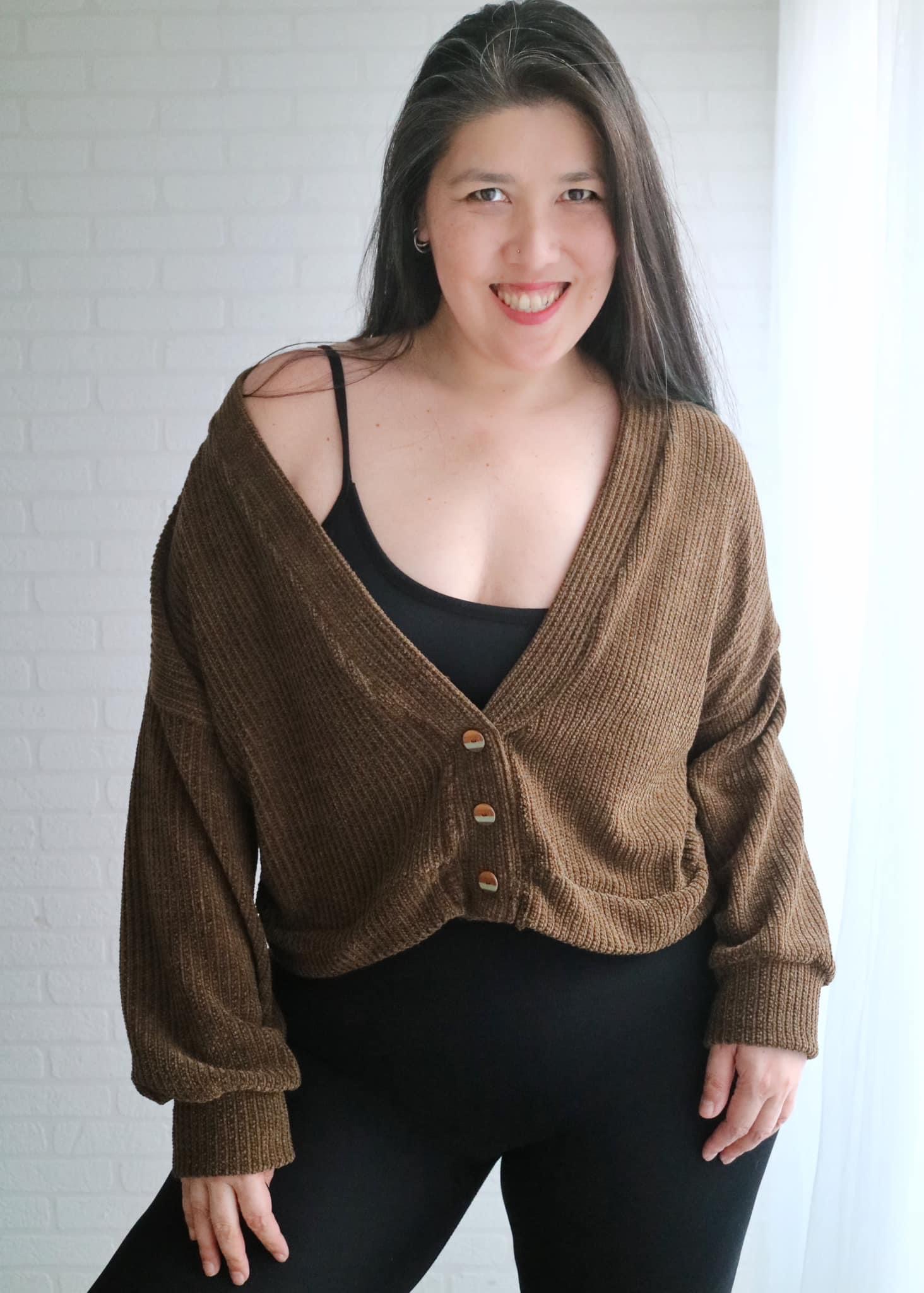Sewing garments with knits can be a breeze, but sometimes the knit fabrics we use can get a little tricky. These include lightweight fabrics great stretch but low recovery, like sweater knits, and they tend to do what they want! They’ll grow, curl, you name it! But with the proper preparation and technique, these beautiful fabrics can be used to sew gorgeous garments of all kinds with professional-looking results. Follow these tips and tricks to help you sew these tricky knits with more confidence.
Understanding Your Fabric

Like all fabrics, tricky knits can be made in a variety of weaves and fibers. For the purposes of this blog post, we’ll be talking specifically about fabrics that are lightweight, with great stretch and low recovery that have a tendency to “grow.” Many sweater knits can fall under this category. They’re amazing to wear, beautiful and soft, but need to be handled a little differently when used. Other names that these fabrics can be categorized under are rib, slub, bouclé, hacci, waffle, or thermal knits, among others!
What is stretch percentage?
Stretch percentage is the amount of give a fabric has when held in a fixed position and stretched in the opposite direction. You will often hear terms like “2-way” or “4-way” stretch in fabric descriptions, and this corresponds with the vertical and horizontal stretch of a fabric. Horizontal stretch is across the fabric, selvedge to selvedge (or the machine finished edges of your fabric) . Vertical stretch is the stretch that run from cut edge to cut edge. If a fabric has 2-way stretch, it stretches only one direction, usually horizontally. 4-way stretch means a fabric stretches both vertically and horizontally.
What is recovery?
Recovery of a fabric has to do with the amount of “bounce back” factor a fabric has. It essentially is fabric’s ability to go back to its original size and shape after being stretched. After being stretched, does the fabric bounce back easily to its original shape? If so, it has great recovery. If it “grows” or is distorted after being stretched, then this knit has low recovery and will need to be handled in a specific way to maintain the integrity of the shape and size of the garment sewn. Luckily, you’re in the right place to learn how to do just that!
Choosing the Right Tools
Pattern Weights and a Rotary Cutter
Because of their lightweight, stretchy nature, fabrics like sweater knits can easily grow and become distorted when using scissors. Try using pattern weights and a rotary cutter to cut lightweight knits accurately and quickly.
Serger
While not a requirement, sergers go a long way in making sewing with lightweight tricky knits easier. The feed dogs of a serger generally don’t tend to “eat” lightweight knits as much as a traditional sewing machine does, and some sweater knits can also unravel, so a serger’s ability to finish raw edges is a definite plus. Changing settings of a serger that assist in the construction of sweater knits, such as the differential feed, is also very simple to do, but more on that later!
Ballpoint Needles
Whether using a serger or a sewing machine, using a ballpoint needle is essential so that you don’t pierce the fabric while sewing. Always follow the recommendation from your machine’s manual, but for fine knits we recommend a 70/11 sized needle, and for heavier knits we recommend an 80/12.
Walking Foot
Not a required tool, but if you’re using a sewing machine to sew tricky knits a walking foot can be very useful for helping to prevent the top layer of fabric stretching out while sewing. Basically, this foot works in partnership with the feed dogs on your machine to grip and pull the layers of fabric evenly and smoothly under the foot as you stitch.
Steam Iron
Using an iron with a steam setting to press your seams after sewing lightweight knits is essential. If any unwanted stretching takes place during the construction process, the stem of the iron will help it shrink back into place!
Preparation is Key
Prewash Your Fabric
While it’s always something we recommend before starting a project, prewashing your knits that are lightweight, stretchy and with low recovery is extremely important as these types of knits tend to shrink easily. Before you wash, check the product description to ensure that you are following proper care instructions for your particular fabric type.
Stay Stitching

After cutting out your fabric pieces, applying a staystitch to curved edges, particularly to necklines, help them to maintain the integrity of their shape and prevent growing. Simply sew a line of straight stitches at normal length along the curved raw edge of the fabric piece, within the seam allowance, which will hold the shape of the curve in place until you attach a neckband.
Sewing Techniques
Adjusting your machine settings is particularly important when sewing with lightweight stretchy knits. Every machine is different, so please refer to your machine’s user manual for instructions on how to adjust your specific machine. However, here are some general guidelines we like to follow when sewing tricky knits:
Sewing Machine Settings
- Lower Presser Foot Pressure: If you don’t have a walking foot, lowering the tension of the presser foot will help the fabric slide through the machine easily.
- Lengthen Your Stitch Length: A longer narrow zig-zag stitch is the perfect stitch to use while constructing garments out of tricky knits. We like to use a stitch with a length of 2.0 mm and a width of 3.0 mm, but try a few practice rows on a piece of strap fabric until you get the desired results. Once you sew a row of stitches that lays flat and does not stretch the fabric, you know you’re on the right track!
Serger Settings
- Lessen Pressure Foot Pressure: Turn the knob so that your presser foot pressure is at a minimum. Make sure to test on a piece of scrap fabric to ensure that the fabric glides easily over the serger’s feed dogs.
- Differential Feed: Did you know that your serger has two sets of feed dogs? It’s true! The differential feed settings of your serger is what controls the speed in which each of these feed dogs move in relation to each other. Set at N or neutral, the feed dogs move at the same speed. When working with a lightweight knit with high stretch and low recovery, we like to increase the differential feed to slightly above 1. This will cause the front feed dogs to move faster than those at the back, helping your fabric to move smoothly through the machine.
- Baste Seams Before Serging: Another useful tip is to baste seams together before serging. If you have made the necessary adjustments to your serger and are still having trouble maintaining the shape of your fabric, basting your seams with a long straight stitch on your sewing machine before serging will help to minimize any distortion.
Using Clear Elastic to Stabilize Seams

Adding clear elastic to seams that tend to grow, like a waistlines and necklines, is an excellent way to prevent them from stretching out. It might seem complicated at first glance, but it really is a simple process! Here’s how:
- Cut a length of clear elastic that is slightly longer than the seam you are applying it to. This will help you to feed it through the machine smoothly.
- Place the clear elastic either on top of the two layers of fabric or sandwiched between the two. This will keep the clear elastic from coming into direct contact with the feed dogs of your machine.
- Simply stitch together your seam, stitching over the clear elastic. Make sure not to stretch either the elastic or the fabric- clear elastic should be added to seams at a 1:1 ratio.
Steam to “Erase” Any Mistakes!

Pressing finished seams and hems with a steam iron goes a long way to hiding any waves, distortions, or unwanted growth in your garment. The steam helps the stitching and fabric to bounce back into shape. Remember- if you think you’ve made a mistake, always try giving it a really good steam first. It might just fix it for you!
We hope that this collection of tips and tricks helps you to sew tricky knits with confidence! With the proper preparation and a few adjustments of your machine, you can sew up beautiful lightweight knits with gorgeous, professional-looking results. – Caitlin
We hope Caitlin’s tips make your upcoming Everly pattern that much easier to sew up! We can’t wait to see.







Leave a Reply